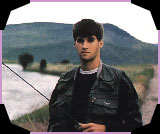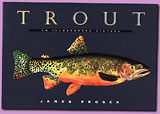
 James Prosek
James Prosek
interviewed by Michael Agger on September 10, 1996
Related Links
Hemingway's Literatour: Flyfisher or not, if you've read Hemingway's "The Sun Also Rises," you'll remember the classic Pyrenees fishing scene. Take the Tripod Literatour and retrace Hemingway's steps.
Flyfish.com: a clearinghouse for all flyfishing information on the Web.
flyfishing FAQs: information on all aspects of flyfishing compiled by the rec.outdoors.fishing.fly newsgroup. A great reference source.
Lefty's World: renowned flyfisherman Lefty Kreh has put his stamp on a professional Web fishing journal. Excellent tips and articles, but they make you pay for the really good stuff.
Trout and Salmon: read this magazine from the land where flyfishing began, Great Britain.
Reel-Time: the Internet journal of salt water flyfishing.

"The instructive nature of the trout stream is not forced upon its visitors, but held candidly by the waters and the trees. The angler must make an effort to hear the stream's messages and see her beauty."
-
- James Prosek
James Prosek is the author of "Trout: An Illustrated History," a watercolor catalog of North American trout. On the strength of these paintings, Prosek has been heralded as "a fair bid to become the Audubon of the fishing world." Not bad for a senior in college! Prosek is currently an English major at Yale, where he is writing his senior thesis on Izaak Walton. Tripod recently spoke to him about his love of fishing and his gift for illustration.
Tripod: In the introduction to "Trout: An Illustrated History," you write how the paintings in the book are actually the fourth set you have done. How did this all start? When did you begin sketching and drawing trout?
James Prosek: Well, my father introduced me to nature mostly through his love of birds. He was born in Brazil and he and his brother would catch tropical songbirds and keep them in cages. When I was a kid, we would go on walks near our home in Connecticut and he would point out the different kinds of birds to me. He also brought home the paintings of Audubon and this other painter, Fuertes. The Audubon book spent more time on our kitchen table than in the local library.
Those two artists captured my heart in the beginning. I started copying their bird drawings, but when I was nine I was introduced to fishing by a friend at school. Soon my drawings of birds became drawings of fish. The first trout painting I did was a copy of a Winslow Homer painting. After that, I continued to paint all kinds of trout. Then, in about 1989 or so, an article appeared in "Yankee" magazine about a rare type of trout called the blueback trout that can only be found in certain lakes in Northern Maine. I went to the library to look up this fish, but could not find a complete catalog of trout. That's where I got the idea to create an Audubon-like book on North American trout.
Tripod: The "Trout" book catalogs over fifty different kinds of trout, some of them extinct. How were you able to track down all these trout species?
JP: I wrote letters to wildlife departments around the country and asked what kind of native trout they had nearby. The rangers and wildlife biologists were very helpful. They sent me published papers, photographs, and written descriptions of the native trout. I also visited a lot of these places myself to see the trout first-hand.
Tripod: Did you catch the blueback trout in Maine?
JP: My friend and I drove up to northern Maine, where the lakes which hold the remaining blueback trout populations are found. It was a very warm July in Maine, so the fish were staying very deep, down in the dark, cold water. Towards night on the third day, I caught a blueback trout with a muddler minnow on a sinking line. The blueback is a very beautiful fish; that was a special moment.
JP: Lots of ways. One of the most fascinating things to me is how a natural barrier like a waterfall can create a species or subspecies. The waterfall is created at some point during the trout's evolution after the trout have invaded the stream. As time passes, the separated trout populations evolve differently. Also, huge iced dams formed during the glacial period, separating fish from each other, and creating different kinds of trout. That is what they think happened with the Yellowstone cutthroat and the Snake River cutthroat.
Trout can even cross the Continental Divide. The headwaters of the Yellowstone River are connected to the headwaters of the Snake River at Two Ocean Pass by a creek called Pacific Creek. There are one or two connections like this that still exist. These creeks are how a trout that's originally from the Pacific gets to the other side of the Divide without man's help.
Tripod: How does it feel to be published so young?
JP: Well, I don't want to be known just as a fishing writer for the rest of my life, but having the book published did allow me to meet many of my fishing heroes. Just last weekend, I went fishing in the Catskills with Ed VanPut, a legendary flyfisherman who only fishes with an Adams dry fly. It has been neat to meet a few of the people who I have been reading about since age ten.
Tripod: Why are illustrators often placed in a different category than fine artists?
JP: I've been pondering the difference between illustrating and painting, and wondering if I am one or the other, or even if the distinction is important. Norman Rockwell walked the fine line between these two. I am not quite sure why these distinctions are made. Fuertes is a wonderful painter and illustrator.

JP: Well, I think the allure of trout cannot be separated from the crystal clear streams that they live in, some of them resembling liquid air. I consistently come across passages in literature, from Dante to Yeats, about encountering a situation by a stream that inspired them to write. There is something about the mystery of the trout and the stream, and the way it is a world we cannot really cross into, that captivates. The way you never see a dead trout makes them seem almost immortal. The stream itself is immortal in its cycle. It flows down to the ocean, comes up into vapor as a cloud, and falls down again as rain.
But, putting all the romantic stuff aside, I like to catch fish.
Tripod: Do you think we make too much out of fishing? What do you think of people who dedicate their lives to fishing?
JP: I personally enjoy the contrast between the life in a city and the life you find by a trout stream. Making trout fishing your life is not the ideal.
Tripod: Do you have any other fishing projects in the works?
JP: Well, I had sent out these proposals to do a change of millennium epic poem about God, and an editor at William Morrow who had read some press about the trout book suggested that I write a book about my fishing mentor instead. My mentor is Will Haines, a park ranger in Connecticut. The new book will be twenty little stories about places we have gone, about his friends, and each will include a sketch. He's a comical guy in an unassuming way.
Tripod: Let's talk more about your fishing mentor.
JP: He is a warden for the local reservoirs in Connecticut. He basically lives off the fish he catches and the animals he kills, which is unique for someone living in Southwestern Connecticut in this age, especially so close to New York City. He's like a raccoon; he'll eat anything.
JP: What kind of wife could tolerate a guy like that? Actually, he is married and she is very understanding. They are Jehovah's Witnesses so she likes letting him be the husband, she the wife, that sort of thing. I ask him, "Will you be able to fish in heaven, if you get there? You know you are not supposed to kill anything in heaven." He says, "No, I will probably be content without it." But I cannot believe that. Anyway, one day he caught me fishing illegally at the reservoir he patrols. This was the start of our friendship. His son had moved out to Colorado, and I sort of became a replacement.
Tripod: I suppose that once you have been compared to Audubon, it is difficult to think of a next step. Where do you see yourself going with your writing and painting?
JP: I have also been writing poetry since I was twelve or thirteen. That is a big part of my life too. I like to sketch and paint and play guitar, but "Trout" has definitely been the biggest part of my life. I am not really sure what I am going to do next.
Tripod: Any final thoughts on fishing? I always like to tell people that fishing is just an excuse to be near a stream.
JP: Streams are special. We all have streams running in us, in our blood. They are magical places.
